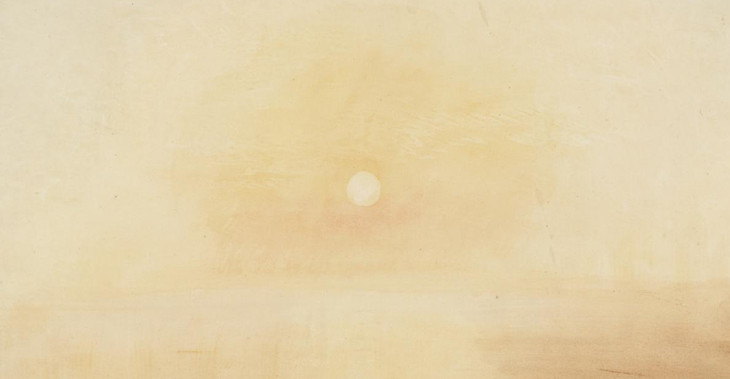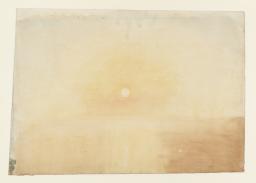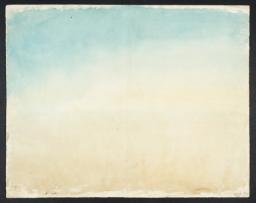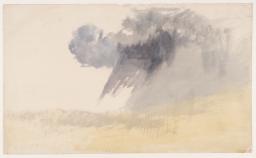From the entry
The watercolours in the present section, showing skies in various moods, whether serenely empty, filled with stormy clouds or as a setting for the disk of the sun itself at dawn or sunset, are, in the phrase of A.J. Finberg, the Turner Bequest’s first cataloguer, ‘colour beginnings’. Many technically similar works in the Turner Bequest evoke, however slightly, specific landscape and townscape settings in relation to Turner’s finished watercolours, such as the series engraved as Picturesque View in England and Wales (see the ‘England and Wales Colour Studies c.1825–39’ section in the present catalogue). Such studies were made either directly in connection with particular subjects to establish their overall composition and mood in terms of light and weather effects, and these sky studies act as an extension or complement to that exploratory process. Eric Shanes has noted that the finished England and Wales designs are ‘often superimposed over ...
D17180, D25178, D25186, D25190, D25193, D25200, D25202, D25206, D25241, D25244, D25253, D25254, D25258–D25262, D25271, D25273, D25287, D25292, D25295, D25296, D25299, D25329–D25332, D25358, D25394, D25400, D25403, D25406, D25412, D25415, D25424, D25453, D25460, D25476, D25513, D29026, D35874, D35875, D40146, D40303, D40304, D41486
Turner Bequest CXCVI P1, P2, P3, CCLXIII 56, 64, 68, 71, 78, 80, 84, 119, 122, 131, 132, 136, 137, 138, 139, 140, 149, 151, 165, 170, 173, 174, 177, 207, 208, 209, 210, 236, 271, 277, 277v, 280, 283, 289, 292, 301, 330, 337, 337v, 353, 389, CCXCII 75, CCCLXIV 35, 36
Turner Bequest CXCVI P1, P2, P3, CCLXIII 56, 64, 68, 71, 78, 80, 84, 119, 122, 131, 132, 136, 137, 138, 139, 140, 149, 151, 165, 170, 173, 174, 177, 207, 208, 209, 210, 236, 271, 277, 277v, 280, 283, 289, 292, 301, 330, 337, 337v, 353, 389, CCXCII 75, CCCLXIV 35, 36
The watercolours in the present section, showing skies in various moods, whether serenely empty, filled with stormy clouds or as a setting for the disk of the sun itself at dawn or sunset, are, in the phrase of A.J. Finberg, the Turner Bequest’s first cataloguer, ‘colour beginnings’.1 Many technically similar works in the Turner Bequest evoke, however slightly, specific landscape and townscape settings in relation to Turner’s finished watercolours, such as the series engraved as Picturesque View in England and Wales (see the ‘England and Wales Colour Studies c.1825–39’ section in the present catalogue).2 Such studies were made either directly in connection with particular subjects to establish their overall composition and mood in terms of light and weather effects, and these sky studies act as an extension or complement to that exploratory process.3
Eric Shanes has noted that the finished England and Wales designs are ‘often superimposed over extremely spontaneous underpaintings’4 (see also the technical notes below). Some of the works included in the present section are similar in character and from the same period, but connections to specific aspects of Turner’s contemporary topographical projects are either not to be found or yet to be made. Another section comprises the Bequest’s ‘Little Liber c.1823–6’ watercolours, which are transitional works, being effectively private studies of twilight, moonlight and cloud effects, unfinished to any traditionally understood degree, yet used directly as the basis of engraved images.
Shanes’s 1997 Watercolour Explorations Tate exhibition catalogue focused particularly on the extensive Turner Bequest sections established and named by A.J. Finberg (CCLXIII ‘Colour Beginnings’,5 CCCLXIV ‘Miscellaneous: Colour’6 and CCCLXV, also ‘Miscellaneous: Colour’7), ordering them in relation both to print projects and broader themes such as ‘Diffused seascapes and skies’, ‘Sky Sketches’ and ‘Washes or “Lay-ins”? Underpainted’.8 Works from the first two groupings are included here, as well as a handful from other sections.9 In presenting a substantial illustrated selection of such works, Gerald Wilkinson had previously made more informal, intuitive groupings such as ‘The elements’, ‘Sunrise and sunset’ and ‘Clouds’.10 Both authors’ classifications are noted in the individual entries, which are arranged in three categories (‘Sun and Clouds at Dawn and Sunset’, ‘Clear or Hazy Skies’ and ‘Clouds, Storms and a Rainbow’); see the introduction to each for further comments. Sometimes the sky and sun feature within slightly more developed landscapes or seascapes, and such works are grouped in the present catalogue in generic sections such as ‘Lowland and River Colour Studies c.1820–40’.
Finberg dated the whole Turner Bequest CCLXIII ‘Colour Beginnings’ section to around 1820–30,11 but those here are here given a broader range of 1820–40, reflecting the artist’s work on similar sheets in relation to dated projects during the 1820s and 1830s, except in cases where a watermark provides a terminus post quem, or other factors come into play, extending the overall dates of this section by half a decade at each end.
As a child, Turner had been paid twopence a time to hand-colour the topographical engravings in a copy of Henry Boswell’s 1786 book Historical Descriptions of New and Elegant Picturesque Views of the Antiquities of England and Wales (Hounslow Libraries), ‘often with imaginative handling, especially of the skies’,12 as Shanes has noted. Evidently he was already considering not just the architectural and historical significance of buildings and their settings, but also their appearance under atmospheric and meteorological conditions.
Turner’s subsequent pencil studies of the weather and the sun in his sketchbooks are extensive but somewhat unsystematic; while his topographical records of landscapes and architecture most often have blank skies devoid of indications of the weather or the time of day, there are hundreds of complementary pages where the sky is the focus, often in terms of cloud formations, covered in written notes of their colour or tone.13 These reflect both a ‘scientific’ observational interest in meteorology (see the Introduction to the subsection of cloud studies here)14 and an artistic concern with the effects of light in the landscape, mediated by Turner’s reverence for Claude Lorrain (1604/5–1682) in particular (see the Introduction to the subsection of sun studies).
Technical notes:
The works in this section are generally characterised by broad watercolour washes on white wove paper. Eric Shanes has discussed the techniques of the ‘colour beginnings’ in some detail.15 In particular he notes that Turner worked on groups of designs at the same time, sometimes within the same sheet of paper and subsequently divided.16 Specific cases are discussed in the individual entries.
Ian Warrell has noted that by the late 1810s ‘Turner habitually worked in batches, laying down the foundations of his designs as broadly painted, parallel bands of colour, the blue for the sky diluted imperceptibly to nothing as it meets the earth tone below it’ for convenience, but the practice also probably arose from his ‘continued scrutiny of the way Claude [Lorrain] prepared the skies in his paintings’, in a similar manner,17 as reportedly described by the then President of the Royal Academy, the painter Benjamin West (1738–1820), in 1799, when Turner was becoming acquainted with Claude’s paintings:
Claude began his pictures by laying in simple gradations of flat colours from the Horizon to the top of the Sky, and from the Horizon to the foreground, witht. [sic] putting clouds into the sky or specific forms into the landscape until he had fully settled those gradations.18
See Eric Shanes, ‘Beginnings’ in Evelyn Joll, Martin Butlin and Luke Herrmann (eds.), The Oxford Companion to J.M.W. Turner, Oxford 2001, pp.21–3; among many other accounts, see also Andrew Wilton in Martin Butlin, Wilton and John Gage, Turner 1775–1851, exhibition catalogue, Royal Academy, London 1974, p.26; and Andrew Wilton, J.M.W. Turner: His Life and Work, Fribourg 1979, p.187.
See Ian Warrell, Turner: The Fourth Decade: Watercolours 1820–1830, exhibition catalogue, Tate Gallery, London 1991, p.41.
See A.J. Finberg, A Complete Inventory of the Drawings of the Turner Bequest, London 1909, vol.II, p.814.
Categories in ‘Appendix I’ in Eric Shanes, Turner’s Watercolour Explorations 1810–1842, exhibition catalogue, Tate Gallery, London 1997, pp.93–103.
The author is also very grateful to fellow Tate Turner cataloguers Alice Rylance-Watson and John Chu for intensive discussions in late October 2014, when the contents of the sections of separate sheets then remaining to be catalogued were largely drawn up.
Eric Shanes, Turner’s Picturesque Views in England and Wales 1825–1838, London 1979, p.16; see also David Hill, Turner on the Thames: River Journeys in the Year 1805, New Haven and London 1993, p.3.
See also James Hamilton, Turner and the Scientists, exhibition catalogue, Tate Gallery, London 1998, pp.63–8, and Inés Richter-Musso, ‘Air’ and ‘Fusion’ in Richter-Musso, Ortrud Westheider and others, Turner and the Elements, exhibition catalogue, Bucerius Kunst Forum, Hamburg 2011, pp.[146]–51, [208]–10.
How to cite
Matthew Imms, ‘Colour Studies of the Sun, Skies and Clouds c.1815–45’, March 2016, in David Blayney Brown (ed.), J.M.W. Turner: Sketchbooks, Drawings and Watercolours, Tate Research Publication, November 2016, https://www




